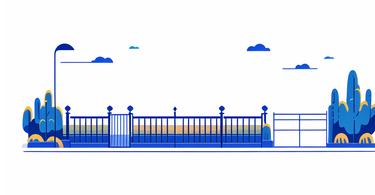The Evolution of Fencing and Gate Technologies in the US Market
Understanding the Current Landscape
The US fence and gate market has evolved greatly. Early fences were simple: wood or stone. Now, we find a mix of traditional and high-tech options. From wrought iron to smart gates, the variety is vast. Advanced materials offer strength and good looks. Tech features allow for remote access or enhanced security. The market now cares for both safety and style. Buyers can choose from eco-friendly or automated solutions. The industry responds to diverse user needs with innovation.
Key Innovations Driving Change
The US market has seen game-changing fence and gate upgrades. These key innovations include improved materials that boost durability and beauty. Also, there are new smart technologies that offer better security and convenience. Designs have also changed, with a move towards eco-friendly options. Here is a list of some major advances:
- Composite materials: Combining wood with plastic makes fences stronger.
- Automated gate systems: These allow remote control and monitoring.
- Solar-powered options: These save energy and reduce bills.
- Mobile integration: Control and surveillance through apps increase security.
- Customization: Advances in manufacturing allow for unique designs.
These changes make fences and gates better for homes and businesses. They also fit today’s tech-focused world.
The Impact of Technological Advancements on Security and Access Control
As tech moves forward, US fences and gates are changing. New tools make them more secure and easy to use. Smart systems use codes and faces to keep areas safe. They let the right people in and keep the wrong ones out. We also see remote control access getting popular. This tech affects homes, offices, and public places. It promises to make our spaces safer and smarter.
Navigating Regulatory Compliance and Safety Standards for Fences and Gates
The Importance of Adherence to US Standards and Regulations
In the US, safety and quality in fence and gate installations are non-negotiable. Strict standards and regulations oversee this sector to ensure every fence or gate meets high safety and performance benchmarks. Compliance with these standards isn't just good practice—it's essential. Failing to adhere can result in legal troubles, fines, or worse, harm to users. Manufacturers, installers, and homeowners alike must stay informed on the current regulatory landscape. This knowledge protects their investments and guarantees the welfare of all involved.
How New Policies Affect Fencing and Gate Design and Installation
New policies in the US are reshaping how we design and install fences and gates. These changes aim to boost both safety and aesthetic standards. For instance, guidelines now call for stronger materials to withstand weather and wear. Designs also need clear visibility to help first responders. Correct spacing is crucial to prevent accidents or traps. For safety, gates must open outwards in public places. All these factors lead to better, safer fencing solutions in our communities.
Best Practices for Compliance and Safety in Fence and Gate Manufacturing
For fence and gate makers, meeting US safety standards is key. Below are best practices to follow:
- Stay Updated: Keep track of changes in codes and standards.
- Use Quality Materials: Choose materials that are up to code and will last.
- Test Routinely: Regular tests ensure fences and gates meet safety rules.
- Get Certified: Use products with safety certifications like UL or ASTM.
- Train Staff: Make sure teams know the latest compliance details.
- Document Everything: Keep records of compliance for every project.
By sticking to these steps, manufacturers can ensure their products are safe and legal.
The Future of Fencing and Gate Solutions in the United States
Predicting Innovations: What's Next for Fence and Gate Technologies?
As we look to the future, exciting innovations in the fence and gate industry are looming on the horizon. Experts point to several areas where advancements are poised to make a significant impact. Here are a few trends to watch for in the coming years:
- Materials Revolution: Expect new, cutting-edge materials that offer increased durability with minimal environmental impact.
- Customization through Technology: Personalized design options leveraging 3D printing technology could transform customer choices.
- Automation and Robotics: Greater use of automation in manufacturing and in gate operation will enhance efficiency and user experience.
- Improved Security Features: Look for fences and gates equipped with biometric scanning and advanced surveillance technologies.
- Wireless Connectivity: Integration with home automation systems and IoT devices for remote monitoring and control is likely to become standard.
- Eco-Friendly Solutions: Innovations in solar-powered gates and recyclable materials will address sustainability concerns.
Through blending form with function, these future advancements will not only improve the security and aesthetics of fences and gates but also contribute to the smart technology landscapes of tomorrow’s homes and cities.
The Role of AI and Machine Learning in Enhancing Fence and Gate Functionality
As we forge ahead, AI and machine learning are key players. These smart technologies are changing how we view fences and gates. They offer advanced options for security and management. With AI, gates can now learn patterns and spot unusual activity. Machine learning algorithms help in predictive maintenance. This means fewer breakdowns and better safety. As these tools evolve, they'll bring even more to the table. They'll enhance how we use and interact with these barriers in our daily lives.
The Integration of Smart Fencing and Gating Systems in Smart Cities
Smart cities in the U.S. are adopting cutting-edge fencing and gating systems. These smart systems link to broader urban networks for better security and efficiency. Features often include remote access control and real-time monitoring. They rely on IoT devices for seamless operation within city infrastructure. Smart fences and gates are now vital for urban safety and smart city growth.
